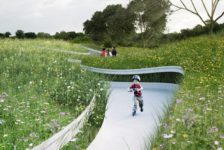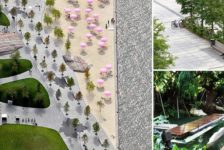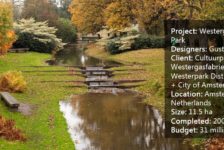Safer streets, cleaner air and water, healthier communities, and a more vibrant economy are all benefits derived from increasing a city’s street trees. As discussed in previous episodes, the importance of urban tree canopy cover is well documented. However, in this week’s episode of Remarkable Objects, “Is Tree Planting Equitable?”, we hear about the inequity of neighborhoods receiving these benefits.
Episode 5 highlights the work of Shannon Lea Watkins, who explored the topic of tree canopy equity while earning her Ph.D. in Public Affairs from the School of Public and Environmental Affairs at Indiana University, Bloomington. In her dissertation “Trees, communities, and equity: Nonprofit tree planting and the coproduction of urban forests,” Shannon examined the role of communities and non-profits in urban forest management. Her later study, “Is planting equitable?”, further delved into the topic, examining where street trees are planted across neighborhoods of varying ethnicities and household income levels. Shannon’s research is aimed at answering the question: “Do non-profit groups plant trees ethically?”. Her studies aim to ensure that trees are being planted where they are needed most— in communities with lower tree canopy cover, lower median income, and a higher number of minority residents. Using data collected from four urban greening non-profit organizations in the Midwest and Eastern United States, Shannon examined the spatial distribution of tree-planting projects and found that disparities may exist.
The research showed that while tree planting programs are more likely to occur in neighborhoods as existing canopy cover and income level decrease, they are less likely to occur as the percentage of racial and ethnic minorities increases. For example, findings show that as the African American population of a neighborhood increased by 1 percentage-point, the probability of the neighborhood having a tree planting program decreased by as much as 2.5 percentage points. In addition, when canopy cover or income was low, tree plantings were even less likely to have occurred in neighborhoods with high percentages of racial or ethnic minorities. This research suggests non-profit tree planting programs might reduce existing income-based inequity in canopy cover, but are not reducing race-based inequity and risk leaving low canopy minority neighborhoods with relatively few program benefits.
So, what are the drivers of this inequity? Shannon outlines four factors that may have affected where non-profits planted trees. First, the physical suitability of the site, such as a lack of existing tree-pits, may have impacted the ability for trees to be planted. Second, unavailable funding sources could be an influencing factor. Third, minority residents may not have known about the resources available to them, leading to a lack of neighborhood interest or understanding. Finally, the capacity of the urban greening non-profits may not have realized or been able to address this inequity.
If inequity is occurring in the pre-application process, the solution may be to reach out to these communities and provide resources to non-profits to further their capacity. However, even if residents are made aware of the non-profit tree planting programs, there are many steps within the process which could inhibit plantings in neighborhoods of high African American or Hispanic minority residents. For example, the requirement to fill out an application may have disincentivized minority neighborhoods to apply. Applications in English only or requiring specific documentation, such as photos of the empty tree pit, could inhibit residents. Support through the application process is critical to help residents get the information needed for the applications. Other barriers within the community could be a lack of maintenance for existing trees that causes residents to be less interested in more trees. Maintaining trees in the long-term is key to the success of sustainable urban forests. Also, inequality could have occurred within the selection process, with overt or covert actions taking place at the non-profit that prevents minority neighborhood selection. If the neighborhoods are not being selected due to lack of tree-pits, the solution may be including the creation of tree-pits as part of the tree-planting programs.
Shannon realizes that we need to work to better understand and serve the needs of minority communities, to gauge interest in tree-planting programs, and determine how to help establish or further the programs. The studies only speculate the causes of this inequity and suggests further research to identify and address obstacles. Shannon recommends that non-profits target low-income, minority, low-tree canopy neighborhoods in their process.
The findings also reveal that non-profit planting programs that engage residents might yield positive outcomes by strengthening communities and overcoming barriers to participation of minority neighborhoods. Collectively, the results suggest that neighborhood groups can play a strategic role in urban forest management.
Ultimately, this is a question of environmental justice. All residents should have equitable access to environmental goods, but if residents have unequal access to urban forests, then they have unequal access to the benefits they provide. This inequity can lead to significant effects on health and well-being. Shannon makes a point to mention that “we see inequity in canopy cover and if we think about environmental injustice or environmental racism, that speaks to that problem. That need not come from explicitly, intentionally racist acts, but the result is still unequal and problematic.” Empowering minority neighborhood residents and listening to their needs will help to ensure they are receiving equal treatment. Providing residents with access to the tree-planting process and influence in decision-making will help ease this disparity and ensure benefits for all.
Shannon is currently a Postdoctoral Fellow at the University of California, San Francisco. To learn more about her research, read “Trees, communities, and equity: Nonprofit tree planting and the coproduction of urban forests” and “Is Planting Equitable?”.
—
Remarkable Objects, hosted by Leda Marritz, Creative Director at DeepRoot, is a new podcast about the intersection of nature and urban design. In each episode, we will hear from leaders and innovators whose work aims to influence the way we think about, design, and build the urban environment.
Remarkable Objects will air every-other Wednesday for the course of the eight-episode season. Check back in two weeks: I will be providing reviews of each episode, as part of the Deep Root and Land8 partnership.
Listen to the full episode here, and subscribe on Soundcloud or iTunes.
Published in Blog








